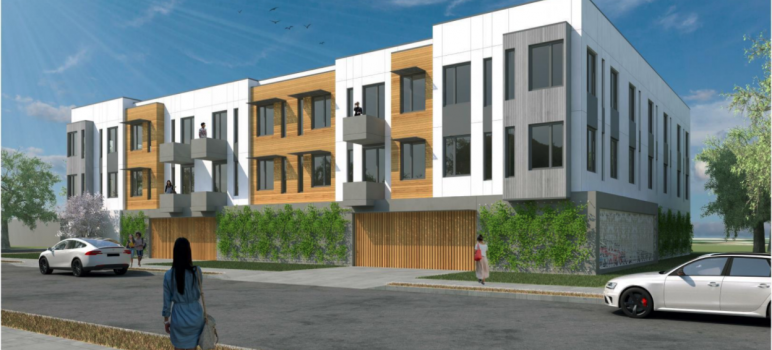Leslye Corsiglia, executive director for housing nonprofit SV@Home, commended the Palo Alto City Council for passing the Planned Home Zoning program last year. The program was meant as a message to developers that city leaders were open to housing, even if it is taller than typically allowed, or on sites that would need to be up-zoned, but the program doesn’t take away the discretionary power of councilmembers to say no to a project. “We need to take away the barriers that make development hard, we need to make it easier to develop, we need to streamline the process for approvals,” said Corsiglia. “It’s great when new progressive policies or plans or projects are approved, but they’ve actually got to be put into operation.”[spacer height=”20px”]
BY: Janice Bitters┃San Jose Inside
PUBLISHED: January 13, 2021
San Francisco-based Cato Investment Co., would bring 24 units in a three-story apartment building on two side-by-side lots at 2239 and 2241 Wellesley St. (Photo courtesy of Cato Investment Co.)
A new proposal to build an apartment building in Palo Alto’s College Terrace neighborhood aims to put to the test the city’s newest zoning program meant to invite housing proposals as city leaders grapple with new staggering state-imposed housing goals.
The project, proposed by San Francisco-based Cato Investment Co., would bring 24 units in a three-story apartment building on two side-by-side lots at 2239 and 2241 Wellesley St. Of those new units, 20 percent would be considered affordable to low-income residents. Today, two single-family houses sit on the lots, though one is condemned, according to Cynthia Gildea a representative for Cato Investment.
The catch in the proposal, called Wellesley Housing, is that the lots at the corner of Wellesley Street and College Avenue—and the entire neighborhood—are zoned solely for single-family homes, a designation not typically simple to change.
“It’s going to be one of those hard things, but it’s also the right thing to do in the right area,” Gildea said. “It’s a perfect mix of everything as far as having transportation close by, a 91 percent walk score, a 100 percent cycling score, it’s going to be close to other multi-family homes. It just fits so nicely in the neighborhood already that just putting in elsewhere doesn’t make as much sense.”
But Cato Investment is hoping the city’s new Planned Home Zoning program, approved last February, will make the process easier. The program builds on the city’s policies to encourage housing by offering incentives to developers that propose affordable homes. The projects proposed under the program can also be mixed-use, as long as they don’t increase the city’s jobs to housing imbalance.
City-specific housing and development programs are becoming increasingly common as the state puts to use stringent rules to promote homebuilding. In response, many cities have offered up their own alternatives to incentivize development without using those state programs, which can force cities to approve projects they otherwise would not have approved.
The Wellesley project will be one of the first tests of the zoning program in Palo Alto, a city that has built a reputation in recent years for approving very little housing—especially affordable housing—compared to its state-mandated housing goals.
The Planned Home Zoning was passed by the City Council as a message to developers that city leaders were open to housing, even if it is taller than typically allowed, or on sites that would need to be up-zoned. But the program doesn’t take away the discretionary power of councilmembers to say no to a project, according to Rachael Tanner, assistant director in the city’s planning department.
“Part of the question is how much flexibility does the council want to entertain?” Tanner said. “The direction at the time was to put out these goalposts, like the 20 percent affordable [requirement], … and then to property owners and developers say ‘bring us your ideas.’”
So far, only two others have tried to take advantage of the program, but Tanner said many developers have contacted the city to say they are interested in proposing projects since its passage.
The first, Palo Alto-based Sand Hill Property Co., has already rescinded its application under the program. The other, a 113-unit apartment complex by Menlo Park-based Acclaim Cos. at 2951 El Camino Real, will next week get a second “pre-screening” for feedback before submitting a formal application.
Wellesley Housing will get a pre-screening for its proposal in the next two to three months. The project currently includes 13 studios and 11 one-bedroom apartments. The remaining 80 percent of the apartments would be rented at rates affordable to those making between 80 percent and 90 percent of the area median income, Gildea said.
“The building itself … will provide units for the ‘missing middle,’” she said. “The prices will be not necessarily below market rate, but below what the current rate for one bedroom units is, according to the Santa Clara County.”
The question now is how councilmembers and local residents will react to the proposal.
Those reactions will determine whether the new homes rise on the site, or if they remain only a rendering as Palo Alto chafes at it’s newly announced 6,100-unit housing development goal by 2031, set by the Association of Bay Area Governments. That number is down from the original 10,000-home goal the city initially was saddled with as of late last year, but city leaders this week still pushed back on the housing allocation because they say it is too high.
Meanwhile, housing advocates say the projects in the pipeline for the Planned Home Zoning program will be a test of how earnest city leaders were in approving it last year.
“I commend them for doing it. We need to take away the barriers that make development hard, we need to make it easier to develop, we need to streamline the process for approvals,” Leslye Corsiglia, executive director for housing nonprofit SV@Home said. “It’s great when new progressive policies or plans or projects are approved, but they’ve actually got to be put into operation.”

